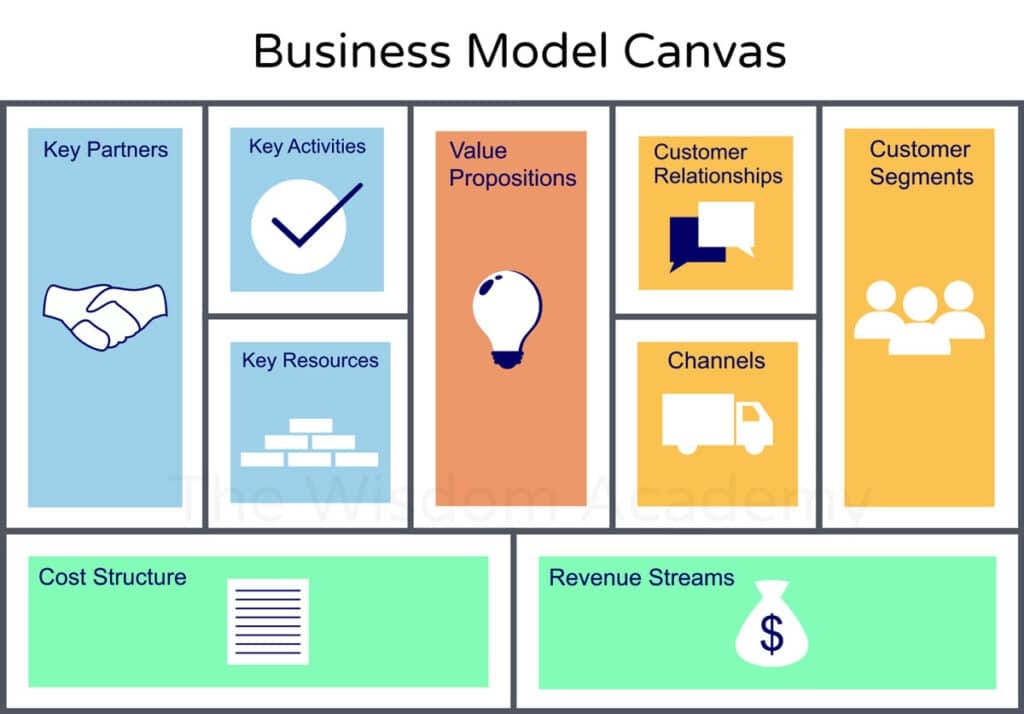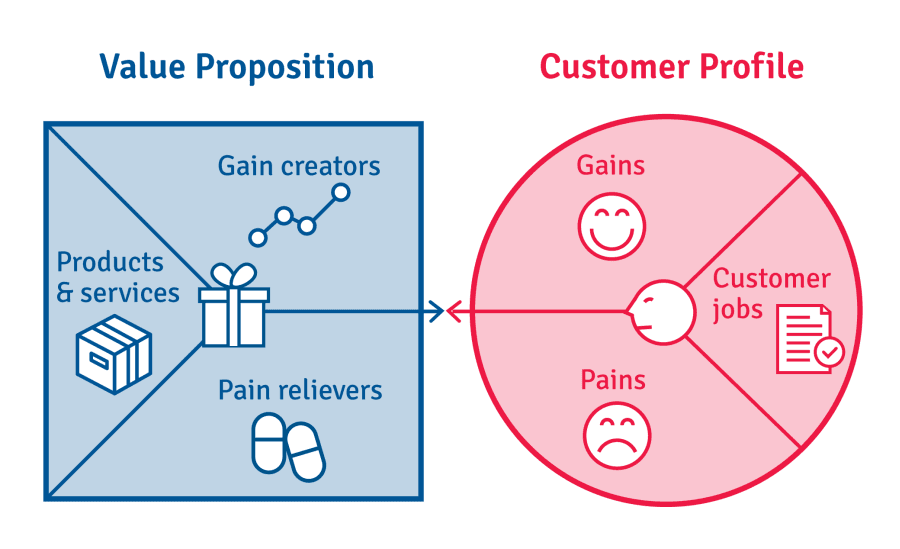Entrepreneurship I - Laying the Foundation, Certification link.
How entrepreneurs can develop new venture concepts, identify attractive market opportunities, build teams, and find early adopter customers
- Introduction to Entrepreneurship : Mindset, Design thinking, Pitching ideas.
- Understanding the Market: Value Proposition Canvas, Market Sizing, Industry Analysis.
- Building the Team: Team, Leadership, Credibility.
- Finding Customers: Early Adopters, Crowdfunding.
1. Introduction to Entrepreneurship
1.1 Entrepreneurship
- The promise of entrepreneurship as a field of research 2000: 提出了基于创业机会的概念框架,将创业定义为"The discovery, evaluation, and exploitation of opportunities"(发现、评估和利用创造未来商品和服务机会的过程)。这个框架强调了创业机会的存在、发现和利用,以及参与这一过程的个体。
- Entrepreneurial Mindset: How to Think Like an Entrepreneur 2020. Entrepreneurial mindset is the combination of beliefs, focus and attitude that collectively constitute a way of thinking, reacting and feeling in an entrepreneurial way.
- An entrepreneur is focused on achieving his vision and does not easily get distracted along the way.
- They believe in their products and services and that they are on a path to solve a real problem for their target customers.
| Entrepreneur Mindset | How to Develop |
|---|---|
| Focus and Vision | Imagine and visualize the big picture, create SMART goals |
| Accepting Uncertainty | Clearly understand and evaluate risk return trade-off, probabilistic thinking |
| Resilience and Perseverance | Don’t be ashamed of your failures, talk to people you trust |
| Adaptability | Know when to change, look for consistent feedback, analysis from multiple data sources |
| Curiosity and Creativity | Ask why and why not, Use observation and combinatorics thinking |
| Bias for Action and Decisiveness | Develop MECE thinking and become data oriented |
| Positivity | Focus on things you can control |
Entrepreneurship Mindset: (this course)
- Creative problem solver.
- Market aware.
- Focused on value creation.
- Tolerance for ambiguity.
- Build-Measure-Learn The Learn Startup - recognize real market need.
- Able to lead others.
- Leadership : Creativity + Leadership leads to Innovation; Innovation + Leadership lead to Entrepreneurship.
- Listen and absorb new information.
- Learn from failure and move on.
- Focus on key success drivers - once you know what they are.
1.2 Entrepreneurial ideas
Design thinking, explained 2017: (1) fully understand the problem; (2) explore a wide range of possible solutions - brainstorm; (3) iterate extensively through prototyping and testing; (4) implement through the customary deployment mechanisms.
Focus on costumers. Driven from experiences.
1.3 Pitching Idea
- How To Pitch To Investors With 13 Slides In Under 10 Minutes 2011
- Watch and Learn From This Startup’s Pitch to VC Tim Draper 2014
- Four-Step Pitch Process:
- Get Them to Listen: Capture attention with originality.
- Get Them to Care: Show passion and the significance of your business.
- Get Them to Believe: Highlight your team’s accomplishments and capabilities.
- Get Them to Take Action: Include a clear call to action, such as scheduling a follow-up meeting.
- Understanding Your Audience: Research potential investors to tailor your pitch effectively.
- Story Telling with conclusions.
- Value Proposition: Clearly articulate how your business solves a problem and the benefits it offers, in 30 seconds.
- Market Size: Demonstrate knowledge of your target market and its potential for growth.
- Total Available Market; Serviceable Available Market; Serviceable Obtainable Market, or “Target Market”.
- Customer Personas: Create profiles of your ideal customers to better understand their needs.
- Sales Strategy (Go-to-market & Revenue model): Outline how you plan to reach customers and generate revenue.
- Competition: Acknowledge competitors and explain how you differentiate your business (build entry barriers).
- Team Credibility: Present your team’s qualifications and experience to build trust with investors.
2. Understanding the Market
How entrepreneurs can achieve product-market fit by designing their product or service to address specific customer needs and requirements, and how they can best communicate their value proposition to customers, investors, and other key stakeholders.
2.1 Value Propositions
Business Model Canvas

Value Proposition Canvas (costumers buy the solutions)

2.2 Market Sizing
TAM SAM SOM - what it means and why it matters: Investors often ask about market size to assess the potential for revenue and sustainability. Total Available Market; Serviceable Available Market; Serviceable Obtainable Market.
- Target Market Selection.
- Investor Expectations :
- SOM should support a viable business.
- Capturing more of SAM should result in attractive returns.
- Dominating SAM and capturing more of TAM should result in a “home run”.
- Estimation method : Top-Down vs. Bottom-Up.
- Steps;
- Define target customers. create a customer archetype.
- Estimate the total number of target customers.
- Estimate your penetration rate. (the percentage who need to buy now)
- Calculate the potential market size : Volume = #Customers * penetration rate; Revenue = Volume * price.
2.3 Industry Analysis
- PEST - external factors: What Is a PEST Analysis? - political, economic, social and technological factors.
- Five Force Analysis - Threat of Entry, Threat of Substitutes, Bargaining Power of Buyers, Bargaining Power of Suppliers, Intensity of Rivalry.
- Industry Mapping - visualize the value chain and identify where to compete effectively.
3. Building the Team
3.1 Team Building
- What makes a successful startup team 2019 - study of 95 new startup teams in the Netherlands. While experience broadens the teams’ resource pool, helps people identify opportunities, and is positively related to team effectiveness, a team also needs soft skills to truly thrive. Specifically, they found that shared entrepreneurial passion and shared strategic vision are required to get to superior team performance.
- 5 steps for building a great startup team 2014 : (1) Identify Positions; (2) Advisers, Contracts, Partners vs. Full Timers; (3) Identify Candidates; (4) The Hiring Process; (5) Post-Hire.
- Don’t start a company with your business school pals 2013: 共享相似的盲点和弱点,在技术或市场洞察力上存在不足;价值观和财务观念的差异可能引发冲突;而且,商学院环境中形成的关系可能无法准确反映一个人在现实商业世界中的表现。
Roles in a Startup: Successful teams typically consist of three key roles:
- Domain Expert: Understands the industry and customer needs.
- Product Expert: Responsible for designing and building the product.
- Business Expert: Manages resources and operations.
Team Dynamics: Founders should have a shared vision and trust each other. Diversity in skills and perspectives is essential for problem-solving.
Key Early Hires: Sales; Product development and engineering; Customer support and engagement; Marketing; Production; Operations; Finance.
Recruitment: Great talent is crucial, and personal networks are often the best source for finding team members. Candidates should thrive in a startup environment and be adaptable.
Advisors: Engaging experienced advisors can provide valuable insights and connections.
3.2 Leadership
- 7 Ways to Lead Successful Entrepreneurial Teams 2016
- 6 Habits of Effective Entrepreneurial Leadership 2016
Definition of Entrepreneurial Leadership: Organizing a group to achieve common goals by managing risk, innovating, and adapting to change.
- Leadership Styles:
- Participative Leadership: Emphasizes teamwork and consensus, allowing team members to contribute to decision-making.
- Assertive Leadership: More autocratic, where the leader communicates a vision and assigns tasks, leading to quicker decision-making but potentially less team motivation.
- Key Responsibilities of Leaders:
- Serve as role models, projecting confidence and optimism.
- Prioritize creative problem-solving and action, even with limited information.
- Recruit and motivate a strong team, ensuring high performance.
- Communicate the company vision and create a sense of urgency with milestones.
- Manage resources effectively, including finances and human resources.
- Maintain personal integrity and manage stress to lead effectively.
3.3 Building Credibility
Building credibility is essential for attracting customers and investors, especially in the competitive startup environment. (Most startup fall, how to persuade others) Persuasion and Evidence: To persuade others to follow, leaders must demonstrate their knowledge and capability.
- Highlight your team’s track record.
- Relevant Experience: Sharing relevant past experiences, especially from similar startups, can enhance credibility.
- Show that you fully understand the opportunity (done your homework)
- Market Research: Conducting thorough market research shows diligence and understanding of customer needs.
- Customer Discovery: Engaging with potential customers to validate assumptions is crucial.
- Comparable Companies: to help understand and persuade that the business model could success.
- Make yourself a A Trusted Authority:
- An early web presence; Social Media; Blogs; White papers and PR; Search Engine.
- Minimum Viable Product (MVP): An MVP helps demonstrate the value proposition and gather feedback.
- Early Adopters.
- Real sales is convincing.
- Turn early adopters into evangelists.
- Partnerships: Collaborating with credible partners can enhance trustworthiness.
- Milestones: Achieving specific milestones can validate the business model and reduce perceived risks.
4. Finding Customers
4.1 Customer Discovery
The goal is to get the Facts.
- Customer Discovery: Tools and Resources 2020 - What is Customer Discovery? A 4-Step Guide to Building the Right Product for the Right Customers 2017
- Define a Hypothesis - My idea solves [insert problem] by [insert solution]. (Problem, Solution, Price, Go-to-Market)
- Define Your Assumptions (create a hypothetical customer persona and think through the assumptions):
- The problem you addressed is actually a problem
- The solution you propose will actually solve the problem
- The market you plan to target has this problem
- The market you plan to target will be willing to pay for your solution
- (Getting Interviews and) Ask (Good) Questions - “get out of the building” and ask some questions - letting the customer lead the conversation.
- Evaluate and Refine
- Getting Interviews:
- Avoid people who know you.
- Ask for referrals.
- Go where the customers are.
- Linkedln and alumni networks.
- Gatekeepers / Executive Assistants.
- Create a landing page.
- Customer Discovery: What Do You Ask, with Justin Wilcox (With Emotions, More Repeats, More Whys. And No Pitching)
- Tell me a story about the last time …
- What was hardest? Why was that hard?
- How do you solve it now?
- Why is that not awesome?
4.2 Early Adopters
- The Secret to Finding (and Winning Over) Early Adopters 2015 : (1) Social Media; (2) Put Yourself in Your Target Market’s Shoes; (3) Create an Acquisition Strategy, map out the buying process.
- Early Adopter
- The pros and cons of early adopters 2024
- Pros : Low barriers to trial; Highly engaged in the category; Word-of-mouth; Influencers.
- Cons : Demanding; Critical; They don’t like mainstream products.
4.3 Crowdfunding
(1) Rewards-Based Crowdfunding: Entrepreneurs offer rewards, typically their product, in exchange for contributions. (e.g. Kickstarter, Indiegogo, …)
(2) Equity Crowdfunding: Allows businesses to raise funds by selling shares to both accredited and non-accredited investors.